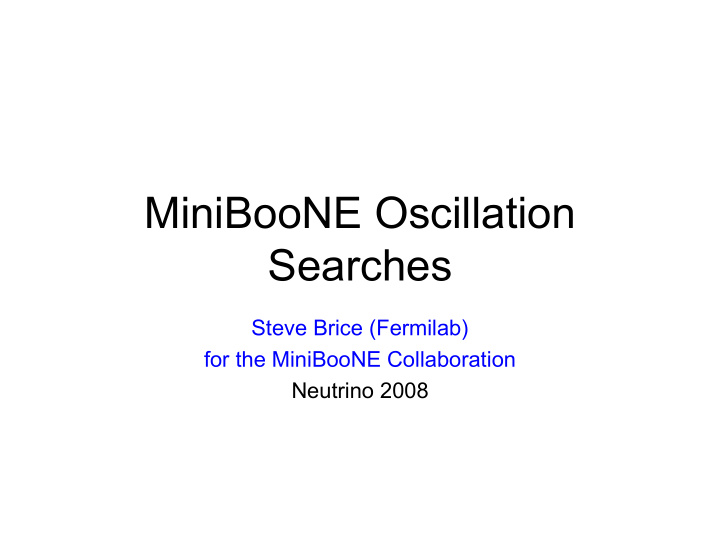



MiniBooNE�Oscillation� Searches Steve�Brice�(Fermilab) for�the�MiniBooNE�Collaboration Neutrino�2008
Outline • Electron�Neutrino�Appearance – Oscillation�Result – π 0 Rate�Measurement – Combining�Analyses – Compatibility�of�High� � m 2 Measurements – Low�Energy�Electron�Candidate�Excess – Data�from�NuMI Beam • Muon�Neutrino�Disappearance • Anti-Electron�Neutrino�Appearance • Summary Neutrino�2008 Steve�Brice�(FNAL) 2
The�MiniBooNE�Collaboration 2�National�Laboratories,�14�Universities,�80�Researchers University�of�Alabama Indiana�University Bucknell University Los�Alamos�National�Laboratory University�of�Cincinnati Louisiana�State�University University�of�Colorado University�of�Michigan Columbia�University Princeton�University Embry-Riddle�Aeronautical�University Saint�Mary’s�University�of�Minnesota Fermi�National�Accerator Laboratory Virginia�Polytechnic�Institute University�of�Florida Yale�University Neutrino�2008 Steve�Brice�(FNAL) 3
The�MiniBooNE�Strategy Test�the�LSND�indication�of�anti-electron�neutrino�oscillations Keep�L/E�same,��change�beam,�energy,�and�systematic�errors P (ν � →ν e ) =� sin 2 2θ� sin 2 (1.27� m 2 L /Ε) neutrino�energy�(E):������ baseline�(L):������������� MiniBooNE:��~500�MeV MiniBooNE:�~500�m LSND:�����������~30�MeV LSND:�����������~30�m� target�and�horn decay�region absorber dirt� detector ν ��� →�ν � � ??? � � π + Booster primary�beam secondary�beam tertiary�beam (protons) (mesons) (neutrinos) ν = ν = ν = ν = 98.1%,� 0.6%,� 1.2%,� 0.03% Event�rates: � � � e Neutrino�2008 Steve�Brice�(FNAL) 4
The�MiniBooNE�Detector 541�meters�downstream�of�target 3�meter�overburden�of�dirt 12�meter�diameter�sphere Filled�with�800�t�of�pure�mineral�oil (CH 2 --density�0.86,�n=1.47) Fiducial volume:�450�t 1280�inner�8” phototubes-10%�coverage, 240�veto�phototubes (Less�than�2%�channels�failed�during�run) Neutrino�2008 Steve�Brice�(FNAL) 5
Oscillation�Analysis�Results:�April�2007 track�based�analysis: Counting�Experiment:����475<E ν <1250�MeV�� Phys.�Rev.�Lett.�98,�231801�(2007) data:�������������380�events expectation:�358� ± 19�(stat)� ± 35�(sys) significance:�0.55 σ No�evidence�for� ν ν � � → ν ν e appearance� ν ν ν ν � � in�the�analysis�region Neutrino�2008 Steve�Brice�(FNAL) 6
� Measuring ν � NC� π 0� and� Constraining� ν e MisIDs • largest� ν � NC� π 0 sample�ever�collected! 28,600� π 0 events � m π ~�20�MeV/c 2 π 0 rate�measured�to�a�few�percent Critical�input�to�oscillation�result�→ without�it,� π 0 background�errors�would�be�~25% arXiv:�0803.3423,�accepted�by�Phys.�Lett.�B Neutrino�2008 Steve�Brice�(FNAL) 7
Oscillation�Analysis�Strategy Two�algorithms�were�used: - “track-based�likelihood” (TBL) Uses�direct�reconstruction�of�particle�types and�likelihood�ratios�for�particle-ID - “boosted�decision�trees” (BDT) Set�of�low-level�variables�combined�with BDT�algorithm�->�PID�“score” - In�the�end,�the�TB�analysis�had�slightly better�sensitivity,�so�was�used�for�primary�results. ����� ���� Neutrino�2008 Steve�Brice�(FNAL) 8
Combining� ν e BDT�+� ν e TBL�Samples paper�at�draft�stage Limits�from�fits�to�open�data The�combination�of�the�two� ν e samples�� gives�an�increase�in�coverage�in�the� region� � m 2 <1�eV 2 . Differences�in�the�details�are�due�to�the� specific�fluctuations�in�the�data�samples� and�the�interplay�with�correlations� Preliminary among�them. The�combination�yields a�consistent�result. 10%-30%�improvement�in�90%�C.L.�limit�below�~1eV 2 . Neutrino�2008 Steve�Brice�(FNAL) 9
Global�Data�Analysis • Combine�results�from�several�experiments�-- LSND,�MiniBooNE,�Karmen and�Bugey • Compatibility – How�probable�is�it�that�all�experimental�results�come�from�the�same� underlying�2- ν osc.�hypothesis? – Assessed�by�combining�the� �χ 2 surface�of�each�experiment • Allowed�regions – Indicate�where�oscillation�parameters�would�lie,�at�a�given�CL,� assuming�all�expt.�results�can�arise�in�a�framework�of�2- ν osc. – The�compatibility�is�the�metric�for�the�validity�of�this�assumption. arXiv:0805.1764�[hep-ex],�submitted�to�Phys.�Rev.�D� Neutrino�2008 Steve�Brice�(FNAL) 10
Global�Fits�to�Experiments � � m 2 � � Sin 2 2 θ θ θ θ LSND KARMEN2 MB Bugey Max.� Compat % 25.36 0.072 0.256 X X X 3.94 0.242 0.023 X X X X 16.00 0.072 0.256 X X 2.14 0.253 0.023 X X X 73.44 0.052 0.147 X X 27.37 0.221 0.012 X X X Neutrino�2008 Steve�Brice�(FNAL) 11
Global�Fit�Results-2D�Fits Colors�represent� � χ 2 • LSND,�KARMEN2�&�MiniBooNE – 25.36% compatibility�at� � m 2 =�0.072�eV 2 ,�sin 2 2 θ = 0.256 • LSND,�KARMEN2,�MiniBooNE�&�Bugey – 3.94% compatibility�at� � m 2 =�0.242�eV 2 ,�sin 2 2 θ = 0.023 Neutrino�2008 Steve�Brice�(FNAL) 12
Low�Energy ν e Candidate Excess Preliminary • No�significant�excess�at� higher�E,�where � ν e� bkgd dominates. • Largest�backgrounds�at� reconstructed�neutrino�energy�bin�(MeV) lower�E�are ν � -induced,� 200-300�����������300-475�������475-1250������� in�particular: Data�����������������������375±19�����������369±19������������380±19 • NC π ��� total�background 284±25�����������274±21������������358±35 • NC� � → N γ� ���ν e intrinsic�������������������26�������������������67������������� 229 • Dirt ���ν � induced����������������258�����������������207�����������������129 Neutrino�2008 Steve�Brice�(FNAL) 13
Updates�to�Low�Energy� ν e Prediction Nearing�the�end�of�a�comprehensive�review�of�the� ν e appearance�backgrounds�and�their�uncertainties → Not�Quite�Ready�for�Release�Yet Neutrino�2008 Steve�Brice�(FNAL) 14
Updates�to�Low�Energy� ν e Prediction Nearing�the�end�of�a�comprehensive�review�of�the� ν e appearance�backgrounds�and�their�uncertainties → Not�Quite�Ready�for�Release�Yet Arrows�indicate�whether�effect�is�to�increase�or�decrease�the�low�energy�data�excess The�effects�have�different�magnitudes�despite�the�arrows�all�being�the�same�size • Included�photonuclear�effect • Photonuclear�absorption� Effect�of�photonuclear�interactions removes�one�of�the�gammas� from�a� ν � -induced�NC� π 0 → γγ – Photonuclear�absorption�was� missing�from�our�GEANT3� detector�Monte�Carlo – Reduces�size�of�excess Neutrino�2008 Steve�Brice�(FNAL) 15
Updates�to�Low�Energy� ν e Prediction Nearing�the�end�of�a�comprehensive�review�of�the� ν e appearance�backgrounds�and�their�uncertainties → Not�Quite�Ready�for�Release�Yet Arrows�indicate�whether�effect�is�to�increase�or�decrease�the�low�energy�data�excess The�effects�have�different�magnitudes�despite�the�arrows�all�being�the�same�size • Included�photonuclear�effect – Absent�from�GEANT3�– creates�background�from� π 0 s • More�comprehensive�hadronic errors – e.g.�uncertainties�in�final�state�following�photonuclear�interaction Neutrino�2008 Steve�Brice�(FNAL) 16
Recommend
More recommend